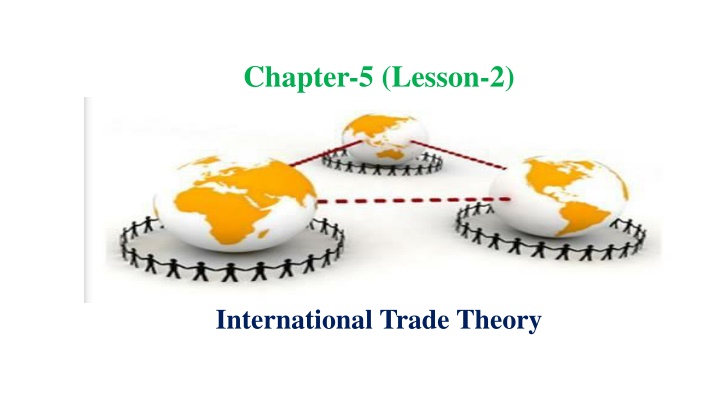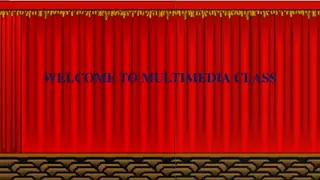
International Trade Theory: New Insights and Implications
Explore the concepts of new trade theory and Porter's diamond of competitive advantage in this lesson on international trade theory. Understand how economies of scale and first-mover advantage impact global trade dynamics.
Download Presentation

Please find below an Image/Link to download the presentation.
The content on the website is provided AS IS for your information and personal use only. It may not be sold, licensed, or shared on other websites without obtaining consent from the author. If you encounter any issues during the download, it is possible that the publisher has removed the file from their server.
You are allowed to download the files provided on this website for personal or commercial use, subject to the condition that they are used lawfully. All files are the property of their respective owners.
The content on the website is provided AS IS for your information and personal use only. It may not be sold, licensed, or shared on other websites without obtaining consent from the author.
E N D
Presentation Transcript
Chapter-5 (Lesson-2) International Trade Theory
Lesson Learning Objectives After reading this lesson the students will be able to; Be familiar with the arguments of those who maintain that government can play a proactive role in promoting national competitive advantage in certain industries. Understand the important implications that international trade theory holds for business practice.
Lesson contents 1. What is new trade theory? 2. The implications of new trade theory for nations 3. Porter s diamond of competitive advantage? 4. Does porter s theory hold? 5. What are the implications of trade theory for managers? 6. What is the balance of payments?
What Is New Trade Theory? New trade theory suggests that the ability of firms to gain economies of scale (unit cost reductions associated with a large scale of output) can have important implications for international trade Countries may specialize in the production and export of particular products because in certain industries, the world market can only support a limited number of firms new trade theory emerged in the 1980s Paul Krugman won the Nobel prize for his work in 2008
What Is New Trade Theory? During the 1980s economists such as Nobel Prize winner Paul Krugman developed what has come to be known as the new trade theory, for which Krugman won the Nobel Prize in 2008. This theory tries to explain why trade is growing fastest between industrial countries 1. With similar economies of scale and endowments of the factors of production (intra- regional trade) 2. Trading similar goods (intra-industry trade)
What Is New Trade Theory? New trade theory makes two important points: First, through its impact on economies of scale, trade can increase the variety of good available to consumers and decrease the average costs of those goods. Second, in those industries when the output required to attain economies of scale represents a significant proportion of total world demand, the global market may only be able to support a small number of enterprises. Thus, world trade in certain products may be dominated by countries whose firms were first movers in their production.
The Implications Of New Trade Theory For Nations Nations may benefit from trade even when they do not differ in resource endowments or technology a country may dominate in the export of a good simply because it was lucky enough to have one or more firms among the first to produce that good Governments should consider strategic trade policies that nurture and protect firms and industries where first mover advantages and economies of scale are important.
Porters Diamond Of Competitive Advantage? Michael Porter (1990) tried to explain why a nation achieves international success in a particular industry Porter identified four attributes that promote or impede the creation of competitive advantage 1. Factor endowments 2. Demand conditions 3. Relating and supporting industries 4. Firm strategy, structure, and rivalry
Porters Diamond Of Competitive Advantage? Determinants of National Competitive Advantage: Porter s Diamond
Does Porters Theory Hold? Government policy can affect demand through product standards influence rivalry through regulation and antitrust laws impact the availability of highly educated workers and advanced transportation infrastructure. The four attributes, government policy, and chance work as a reinforcing system, complementing each other and in combination creating the conditions appropriate for competitive advantage So far, Porter s theory has not been sufficiently tested to know how well it holds up
What Are The Implications Of Trade Theory For Managers? 1. Location implications - a firm should disperse its various productive activities to those countries where they can be performed most efficiently 2. First-mover implications - a first-mover advantage can help a firm dominate global trade in that product 3. Policy implications - firms should work to encourage governmental policies that support free trade
What Is The Balance Of Payments? A country s balance of payments accounts keep track of the payments to and receipts from other countries for a particular time period 1. The current account records transactions of goods, services, and income, receipts and payments current account deficit current account surplus 2. The capital account records one time changes in the stock of assets 3. The financial account records transactions that involve the purchase or sale of assets
Any Question????? Thank you for you nice cooperation






















